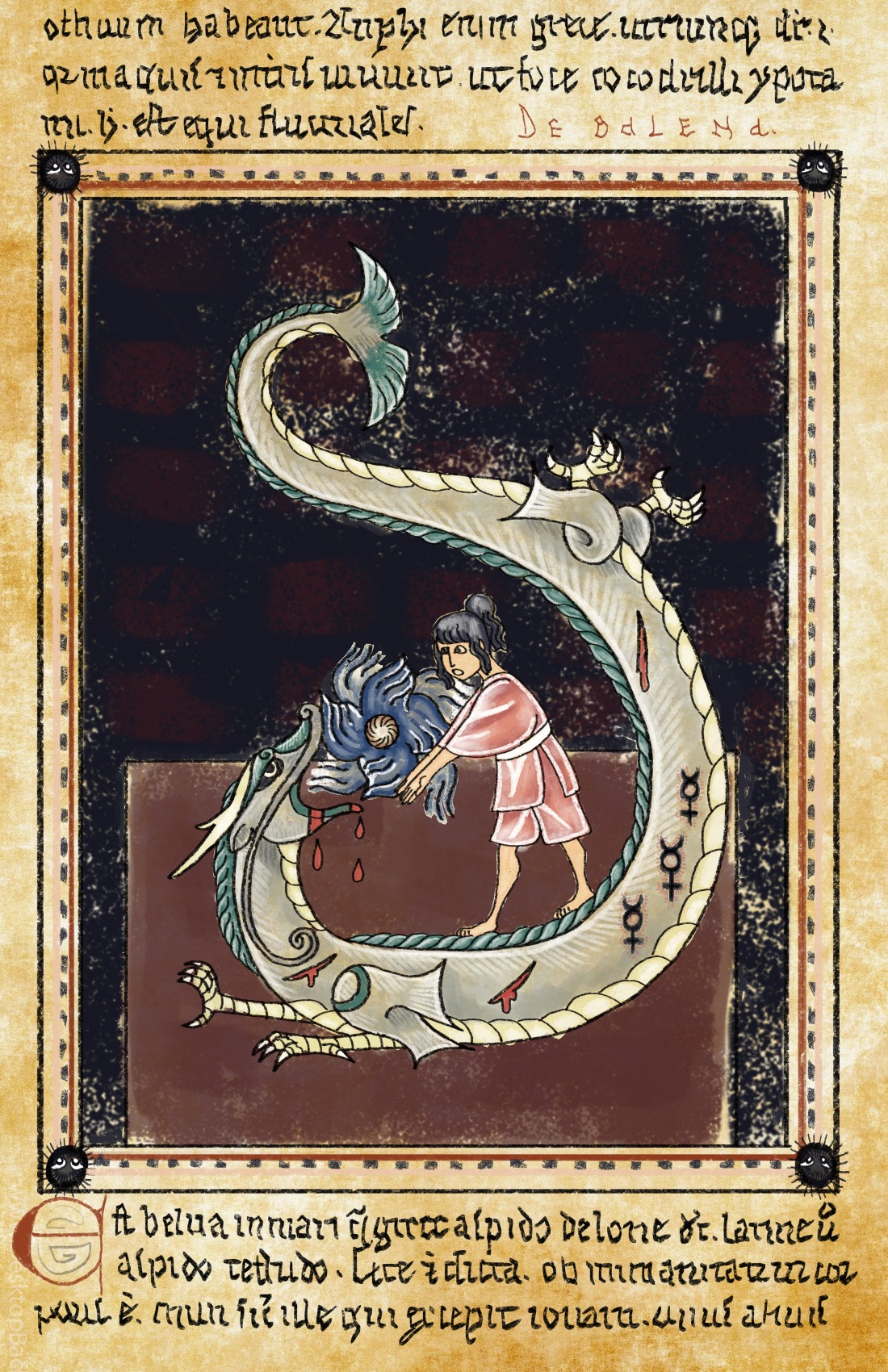Medieval art spans a massive period of over 1000 years from the 4th to the 15th century. This period encompasses an extremely wide variety of art styles from Anglo-Saxon to Romanesque to Gothic and beyond. One major form of art of this time came in the form of illuminated manuscripts. Originally created for churches to spread the ideas of the Christian religion, these books featured illustrated scenes of religious events or stories.(1)

The Whale, MS. Ashmole Bestiary 1511, Folio 86v, c. 1200, Bodleian Library,
This is a page in the manuscript, Ashmole Bestiary 1511 Folio 86v, features a frame scene in middle of a page with text above and below. The scene is framed by a border of stripes and dashes. Within the Border depicts three men in a boat with a single red sail upon the sea. The boat is facing to the right with a man in yellow robes sitting at the stern of the boat on the left, steering. In the middle of the boat facing the stern with his head turned to the right, is a man dressed in blue robes tending to the sail. On the bow of the boat on the right stands a man in orange robes, facing right with head turned back toward the other two men, alerting them to the beast. Below them the ocean rises in a wave using waving lines to depict a swell of water. The image is dominated by a whale colored in dark blue and white lines, swimming in the water beneath the boat. It is facing left as it eats two large fish. There is very little in the way of perspective, the figures and seen are flat with everything taking place in the foreground of the image with only slight overlapping of forms. The environment is limited to a sky of simple black while the ocean consists of a single Mound of blue with waving, patterned lines. The pattern of the water is mirrored in the lines used to color the whale, and in the general weaving pattern in which its many fins are positioned. The colors have faded but it is safe to say that the page was once vibrant in saturated shades of Red orange and blue. All figures in the work feature a dark outline. White highlights and lines are used to create the folds of the fabrics and the edges of the fins with darker tinting of the tones being used to create the illusion of Shadows. Views of the red of the sale successfully draws the eye first to the boat then to the men within the boat and then down to the giant darker form of the whale below.

Medieval Sprited Away, Author.
The scene I chose for my page was from Studio Ghibli’s, Spirited Away, specifically the scene where Chihiro saves Haku after he has been attacked and poisoned for stealing a magical cursed seal. She cures him by force-feeding him a gift she received from a powerful River Spirit earlier in the movie. My page depicts Haku and Chihiro in the dark of the boiler room. Haku is writhing on the floor, mouth open and bleeding from many wounds, facing Chihiro. His body twists in pain from the bottom of the page to the top in a vague s-curve pattern. Atop his back stands Chihiro, dressed in her pink work robes. In her hands she holds the orb shaped medicine of the River Spirit as wave style energy radiates from it while in the borders of the page the soot sprites look on with fear and anxiety. For this scene I faced an unusual problem of translating a Japanese style of artwork and stylized subject matter Into an English medieval style of artwork. Chihiro’s outfit and design luckily was easily translatable but Haku in particular posed a larger problem. Dragons in the Japanese style are long and serpent-like, while in medieval English style dragons tend to be more of a bird or bat winged lizard. So in order to solve this problem I decided to add aspects of a medieval sea monster into Haku’s design. To do this, I Incorporated fins into his body owing to the fact that Haku is a water dragon and medieval people most likely would have seen him as a sea serpent or giant monster fish. To show that Haku has been poisoned I put Mercury symbols along his belly with red outlines making it appear as if he has been branded. Medieval artwork in manuscripts tended to be more literal with their symbolism, preferring to directly depict the scene using text for explanation. This is why I chose to make the Mercury symbols physical wounds. I chose the Mercury symbol because during medieval medical practices Mercury was often thought to have healing powers and was even believed to help Grant immortality. The unfortunate reality was that mercury is incredibly toxic and would more often than not kill the patient rather than save them. This ties in nicely to the fact that Haku had tried to steal the seal in order to gain a bargaining chip for his freedom but instead was being poisoned by it. The reason I chose brands rather than showing the medical procedure itself is because during that time period, mercury was taken rectally by means of a long necked jug.(2) I opted against illustrating this rather graphic procedure, deciding that symbolic brands are more than sufficient and that poor Haku doesn’t need to suffer such an indignity. The background I decided to keep Simple. This is because while the room in the movie was highly detailed, it was very dark and environments in medieval art tended to be glossed over in favor of the characters.
- “Medieval Art and Architecture.” Oxford Art. Accessed November 11, 2018. http://www.oxfordartonline.com/page/medieval-art-and-architecture.
- Andrews, Evan. “7 Unusual Ancient Medical Techniques.” History.com. Accessed November 11, 2018. https://www.history.com/news/7-unusual-ancient-medical-techniques.
- i. “Illuminated Manuscripts.” Medieval Squires. Accessed November 11, 2018. http://www.medieval-life-and-times.info/medieval-art/illuminated-manuscripts.htm.